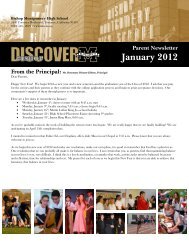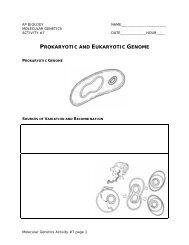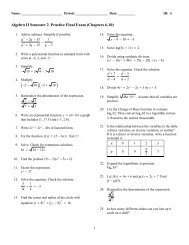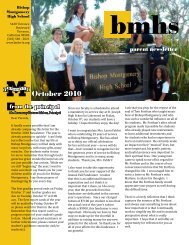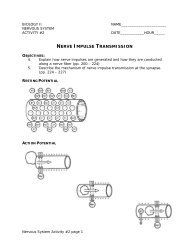blas0006
blas0006
blas0006
- No tags were found...
You also want an ePaper? Increase the reach of your titles
YUMPU automatically turns print PDFs into web optimized ePapers that Google loves.
Presenting DataTo seek answers to problems or questions they have about the world,scientists typically perform many experiments in the laboratory. Indoing so, they observe physical characteristics and processes, selectareas for study, and review the scientific literature to gain backgroundinformation about the topic they are investigating. They then formhypotheses, test these hypotheses through controlled experiments,record and analyze data, and develop a conclusion about thecorrectness of the hypotheses. Finally, they report their findings indetail, giving enough information about their experimental procedureso that other scientists are able to replicate the experiments and verifythe results.The Laboratory Investigations in Laboratory Manual A provide anopportunity for you to investigate scientific problems in the samemanner as that of a typical scientist. As you perform theseinvestigations, you will employ many of the techniques and steps ofthe scientific method a working scientist does. Some of the mostimportant skills you will acquire are associated with the step of thescientific method known as recording and analyzing data. Three ofthese skills are creating and filling in data tables, making drawings,and finding averages. Another set of skills useful in presenting data isexamined in the Laboratory Skills activity titled Using Graphing Skills.It is important to record data precisely—even if the results of aninvestigation appear to be wrong. And it is extremely important tokeep in mind that developing laboratory skills and data analysis skillsis actually more valuable than simply arriving at the correct answers.If you analyze your data correctly—even if the data are not perfect—you will be learning to think as a scientist thinks. And that is thepurpose of this laboratory manual and your experience in the biologylaboratory.Data TablesWhen scientists conduct various experiments and do research, theycollect vast amounts of information: for example, measurements,descriptions, and other observations. To communicate and interpretthis information, they must record it in an organized fashion. Scientistsuse data tables for this purpose.You will be responsible for completing data tables for many of theLaboratory Investigations. Each column in a data table has a heading.The column headings explain where particular data are to be placed.The completed data tables will help you interpret the information youcollected and answer the questions found at the end of eachLaboratory Investigation.© Prentice-Hall, Inc.14 Biology Laboratory Manual A/Presenting Data
Name______________________________ Class __________________ Date ______________EXERCISE 1Given the following information, complete Data Table 1. Theninterpret the data and answer the five questions that follow.Information: The following hair colors were found among three classesof students:Class 1: brown— 20 Class 2: brown— 18 Class 3: brown— 15black— 1 black— 0 black— 4blond— 4 blond— 6 blond— 15Data TableHair Color Class 1 Class 2 Class 3 TotalBrownBlackBlond1. What type of information is being gathered?2. Which hair color occurs most often?3. From the information in the Data Table, can you give the number ofboys with black hair?4. What information can you give about the number of students withblack hair?5. Which class has the most blond students?© Prentice-Hall, Inc.6. How many students made up the entire student population?Biology Laboratory Manual A/Presenting Data 15
EXERCISE 2Given the following information, organize the data into a table. Use theblank area provided in Figure 1 to draw in the necessary columns androws. Then interpret the data and answer the questions that follow.Information: On an expedition around the world, several scientistscollected the venom of various snakes. One of the tests that thescientists conducted determined the toxicity of the venom of eachsnake. Other data obtained by the scientists included the mortalitypercentage, or relative death rate, from the bites of various snakes.The snakes observed were the (1) southern United Statescopperhead, (2) western diamondback rattlesnake, (3) eastern coralsnake, (4) king cobra, (5) Indian krait, (6) European viper, (7) bushmaster,(8) fer-de-lance, (9) black-necked cobra, (10) puff adder.The mortality percentage of people bitten by the snakes variedfrom 100% to less than 1%. The scientists noted the mortalitypercentage for each of the snakes was (1) less than 1%, (2) 5–15%, (3)5–20%, (4) greater than 40%, (5) 77%, (6) 1–5%, (7) usually 100%, (8)10–20%, (9) 11–40%, and (10) 11–40%.Figure 11. Which snake’s venom has the highest mortality rate?2. Which snake’s venom has the lowest mortality rate?3. From the information recorded, can you determine the snake whosevenom works the most rapidly? The least rapidly?4. Which two snakes’ venom have the same mortality rate?© Prentice-Hall, Inc.5. How many types of snakes were observed?16 Biology Laboratory Manual A/Presenting Data
Name______________________________ Class __________________ Date ______________DRAWINGSLaboratory drawings can be made using several methods. Somedrawings are made in circles that represent the viewing field of amicroscope or another type of magnifier. When completing thesedrawings, be sure to include the magnification at which you viewedthe object. Other laboratory drawings represent organisms or parts oforganisms. These drawings show the relative size, shape, and locationof anatomical structures. When completing representative drawings,make the structures as clear and as accurate as possible.Most laboratory drawings are labeled. Use the followingguidelines to help make your laboratory drawings clear and legible.• Use a ruler to draw label lines.• Label lines should point to the center of the structure being labeled.• Do not write on the label lines.• Print all labels horizontally.• Label the right-hand side of the drawing, if possible.• Do not cross label lines.EXERCISE 3The following drawing was made without using the guidelines above.Circle those parts of the drawing that do not follow the guidelines.Then, on the lines provided, explain how the drawing should be done.MagnificationCytoplasmCell wallNuclearmembraneFigure 2© Prentice-Hall, Inc.AVERAGESOccasionally you will be required to find the average of data gatheredfrom an investigation. To find an average, add the items in the grouptogether and then divide the total by the number of items. Forexample, if there were five students of different ages—12, 13, 14, 17,and 19—how would you find the average age of the group? Add thefive ages together and divide the total by 5, which is the number ofitems (students) in the group. What is the average age of this group ofstudents? Your answer should be 15 years old.Biology Laboratory Manual A/Presenting Data 17
EXERCISE 4In a garden the heights of six sunflowers are 135.0 cm, 162.5 cm, 180.0 cm,235.0 cm, 185.0 cm, and 167.5 cm. What is the average height of thesunflowers?EXERCISE 5Find the average for the following group of data. Then use the resultsto answer the questions that follow.In an experiment on plant growth and overcrowding, plants of thefollowing heights are in three equal-sized containers.Flowerpot 1: 20.0 cm and 18.2 cmFlowerpot 2: 12.0 cm, 10.8 cm, 11.2 cm, and 12.4 cmFlowerpot 3: 7.5 cm, 8.0 cm, 6.0 cm, 6.2 cm, 5.8 cm, and 7.3 cm1. What is the average height of the plants in each flowerpot?2. In which flowerpot did the plants grow the tallest? Explain.EXERCISE 6Find the averages for the following groups of data. Express youranswers to the nearest tenth.In a sample group of students, the number of breaths per minutewas measured at rest and after exercise. The results were as follows:At restMales: 10.1, 13.0, 12.5, 10.2, 13.1, 11.8Females: 10.4, 13.0, 12.1, 11.9, 10.5, 12.8After exerciseMales: 18.9, 23.7, 22.6, 21.3, 19.2, 20.6Females: 25.0, 26.7, 29.0, 35.3, 33.1, 31.71. What is the average number of breaths per minute for males at rest?Females at rest?2. What is the average number of breaths per minute for males after exercise?Females after exercise?3. How many students make up the sample group?4. What is the average number of breaths per minute for the entire group at rest?After exercise?5. Do males or females take more breaths per minute at rest?After exercise?© Prentice-Hall, Inc.18 Biology Laboratory Manual A/Presenting Data



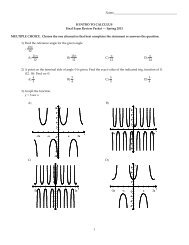
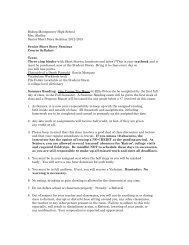
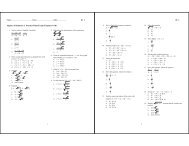
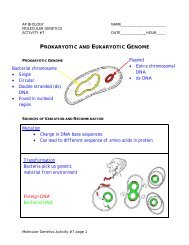


![1. Given: BD is tangent to circle O at C, , and m ACE [A] 41° [C] 40 ...](https://img.yumpu.com/42456754/1/190x245/1-given-bd-is-tangent-to-circle-o-at-c-and-m-ace-a-41a-c-40-.jpg?quality=85)
